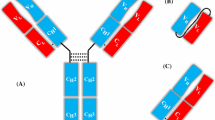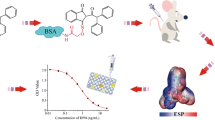Abstract
This study investigates immunoreactivity control procedures, i.e., specificity, affinity constant (K a ), and specific active binding sites (SABS), for polyclonal anticolchicine, monoclonal antidigitoxin IgG and Fab fragments, and antidigoxin Fab fragments (Digidot). Preliminary control procedures for IgG and Fab fragment purity indicated that all reagents were immunologically pure. All IgG and Fab fragments exhibited similar cross-reactivity and K a. No decrease in percentage of Fab fragment SABS was observed after papain cleavage of anticolchicine and antidigitoxin IgG. Nevertheless, only 4.3 ± 1.2% of nonimmunopurified anticolchicine polyclonal Fab fragments and 76.2 ± 2.3 to 88.7 ± 2.5% of different batches of immunopurified anti-digoxin Fab (Digidot) were active, the latter percentage being in the range of the 85% specified by the manufacturer. Only 58 ± 3% of digitoxin-specific monoclonal IgG was active and 67 ± 7% of its Fab fragments. Results show the importance of determining the ratio of SABS to presumed total specific binding sites for pharmaceutical monoclonal and polyclonal antibody preparations against haptens.
Similar content being viewed by others
REFERENCES
W. A. Colburn. Antibodies and their applications. J. Clin. Immunol. 11:37–40 (1988).
J. M. Scherrmann, N. Terrien, M. Urtizberea, P. Pierson, H. Denis, and J. M. Bourre. Immunotoxicotherapy: Present status and future trends. Clin. Toxicol. 27:1–35 (1981).
A. R. Hickey, T. L. Wenger, V. P. Carpentier, H. H. Tilson, M. A. Hlatky, C. D. Furberg, C. H. Kirkpatrick, H. C. Strauss, and T. W. Smith. Digoxin immune Fab therapy in the management of digitalis intoxication: Safety and efficacy results of an observational surveillance study. J. Am. Coll. Cardiol. 17:590–598 (1991).
M. J. Hursting, V. A. Raisys, K. E. Ophelm, J. L. Bell, G. B. Trobaugh, and T. W. Smith. Determination of free digoxin concentrations in serum for monitoring Fab treatment of digoxin overdose. Clin. Chem. 33:1652–1655 (1987).
W. Jiskoot, E. C. Beuvery, A. A. M. de Koning, J. N. Herron, and D. J. A. Crommelin. Analytical approaches to the study of monoclonal antibody stability. Pharm. Res. 7:1234–1241 (1990).
E. Roesch and H. Lenz. Pharmacological and toxicological expertise on sheep anti-digoxin Fab. Boehringer Mannheim 01.014:1–9 (1983).
L. Edelman, A. Collignon, J. M. Scherrmann, E. Fournier, J. Reviron, and J. F. Bach. Preparation and experimentation of an antidigitalin monoclonal antibody: Interest in human treatment. C. R. Acad. Sci. III:421–424 (1982).
R. Pontikis, J. M. Scherrmann, N. Nguyeng-Hoang, L. Boudet, and L. Pichat. Radioimmunoassay for colchicine: Synthesis and properties of three haptens. J. Immunoassay 1:449–461 (1980).
E. J. Cohn, L. E. Strong, N. L. Hugues, C. J. Mulford, J. N. Ashworth, M. Melin, and H. L. Taylor. Preparation and properties of serum and plasma protein IV. A system for the separation into fractions of protein and lipoprotein components of biological tissues and fluids. J. Am. Chem. Soc. 68:459–475 (1946).
R. R. Porter. The hydrolysis of rabbit G globulin antibodies by cristalline papain. Biochem. J. 73:119–126 (1959).
O. Ouchterlony. Diffusion in gel methods for immunological analysis. In Progress in Allergy, Vol. 9, S. Karger, Basel/New York, 1958, p. 1.
O. H. Lowry, N. J. Rosebrough, A. L. Farr, and R. J. Randall. Protein measurement with the Folin phenol reagent. J. Biol. Chem. 193:265–275 (1951).
I. Kjeldahl. European Pharmacopeia, 2nd ed., 1986, p. 275, and 1987, p. 338.
J. M. Scherrmann, M. Urtizberea, P. Pierson, and N. Terrien. The effect of colchicine-specific active immunization on colchicine toxicity and disposition in the rabbit. Toxicology 56:213–222 (1989).
A. Collignon, M. Geniteau-Legendre, C. Sandre, A. M. Quero, and C. Labarre. Specific binding characteristics of high affinity monoclonal antidigoxin antibodies. Hybridoma 7:355–365 (1988).
T. W. Smith, V. P. Butler, and E. Haber. Characterization of antibodies of high affinity and specificity for the digitalis glycoside digoxin. Biochemistry 9:331–337 (1970).
D. D. Keightley and N. A. C. Cressie. The Woolf plot is more reliable than the Scatchard plot in analysing data from hormone receptor assays. J. Steroid Biochem. 13:1317–1323 (1980).
M. C. Manning, K. Patel, and R. T. Borchardt. Stability of protein Pharmaceuticals. Pharm. Res. 6:903–918 (1990).
United States Food and Drug Administration. Points to consider in the manufacture and testing of monoclonal antibody products for human use. Office of Biological Research and Resource 3 (1987).
Committee for Proprietary Medicinal Products: Ad Hoc Working Party on Biotechnology/Pharmacy. Notes to applicants for marketing authorizations on the production and quality control of monoclonal antibodies of murine origin intended for use in man. J. Biol. Stand. 17:213–222 (1989).
M. Bowles, S. C. Johnston, D. D. Schoof, P. R. Pentel, and S. M. Pond. Large scale production and purification of paraquat and desipramine monoclonal antibodies and their Fab fragments. Int. J. Immunopharm. 10:537–545 (1988).
J. S. Huston, D. Levinson, M. Mudgett-Hunter, M. S. Tai, J. Novotny, M. N. Margolies, R. J. Ridge, R. E. Bruccoleri, E. Haber, R. Crea, and H. Oppermann. Protein engineering of antibody binding sites: Recovery of specific activity in an antidigoxin single-chain Fv analogue produced in Escherichia coli. Biochemistry 85:5879–5883 (1988).
Author information
Authors and Affiliations
Rights and permissions
About this article
Cite this article
Cano, N.J., Sabouraud, A.E., Urtizberea, M. et al. Analytical Control Procedures of Immunoreactivity for IgG and Fab Fragments Specific to Haptens. Pharm Res 9, 643–647 (1992). https://doi.org/10.1023/A:1015802110647
Issue Date:
DOI: https://doi.org/10.1023/A:1015802110647




